Physical and Mechanical Behaviors of Compacted Soils under Hydraulic Loading of Wetting–Drying Cycles
Abstract
:1. Introduction
2. Materials and Methods
2.1. Soil Properties
2.2. Experimental Program
3. Test Results and Analysis
3.1. Soil–Water Characteristic
3.2. Soil Void Ratio Characteristics
3.3. Unified Soil–Water Characteristic Surface of Moisture Content, Void Ratio and Matric Suction
3.4. Shear Wave Velocity and Modulus
4. Conclusions
- (1)
- The water retention capacity of soil showed a decreasing tendency in degrees of saturation and moisture contents when the number of wetting–drying cycles increased. Both the desorption and absorption rates were much higher during the first drying–wetting path than the subsequent cycles, and the degree of saturation tended to become smaller at low suction and higher at larger suction;
- (2)
- The compacted CL soil exhibited typical swelling and shrinkage deformations during the hydraulic loading processes, and the differences between the compressibility and swelling indexes were much larger for the first drying–wetting cycle than the second cycle. Accumulative deformation in terms of volume expansion was generated after the drying–wetting cycles, which deteriorated the densely compacted soils to a relatively looser state;
- (3)
- A unified formula was proposed to describe the soil–water characteristic surface of gravimetric moisture content, void ratio, and matric suction for the entire wetting–drying cycles. All the w−e−ψ relationships at different wetting–drying paths were approximately located on the same surface, indicating that the relationship within w, e and ψ was unique;
- (4)
- Shear modulus was found to be dependent on matric suction and the degree of saturation. Wetting–drying cycles gave rise to significant degradation in shear modulus, especially in the first cycle. Consequently, these noticeable influences of the wetting–drying cycles on the performance degradation of the soil−supporting modulus should arouse more attention in practical engineering applications, as these are caused not only by the increase in moisture content, but can also be attributed to the increase in void ratio.
Author Contributions
Funding
Data Availability Statement
Conflicts of Interest
References
- Kodikara, J. New framework for volumetric constitutive behaviour of compacted unsaturated soils. Can. Geotech. J. 2012, 49, 1227–1243. [Google Scholar] [CrossRef]
- Li, Z.S.; Derfouf, F.; Benchouk, A.; Abou-Bekr, N.; Taibi, S.; Fleureau, J.M. Volume Change Behavior of Two Compacted Clayey Soils under Hydraulic and Mechanical Loadings. J. Geotech. Geoenviron. 2018, 144, 04018013. [Google Scholar] [CrossRef]
- Shao, L.T.; Wu, S.X.; Guo, X.X.; Wen, T.D. One-Dimensional Seepage of Unsaturated Soil Based on Soil-Water Characteristic Curve. Processes 2022, 10, 2564. [Google Scholar] [CrossRef]
- Chen, Y.H.; Li, B.Y.; Xu, Y.T.; Zhao, Y.P.; Xu, J. Field Study on the Soil Water Characteristics of Shallow Layers on Red Clay Slopes and Its Application in Stability Analysis. Arab. J. Sci. Eng. 2019, 44, 5107–5116. [Google Scholar] [CrossRef]
- Al-Dakheeli, H.; Bulut, R. Interrelationship between Elastic Deformation and Soil-Water Characteristic Curve of Expansive Soils. J. Geotech. Geoenviron. 2019, 145, 4019005. [Google Scholar]
- Zhao, N.F.; Ye, W.M.; Chen, Y.G.; Chen, B.; Cui, Y.J. Investigation on swelling-shrinkage behavior of unsaturated compacted GMZ bentonite on wetting-drying cycles. B. Eng. Geol. Environ. 2019, 78, 617–627. [Google Scholar] [CrossRef]
- Guo, Z.Q.; Lai, Y.M.; Jin, J.F.; Zhou, J.R.; Sun, Z.; Zhao, K. Effect of Particle Size and Solution Leaching on Water Retention Behavior of Ion-Absorbed Rare Earth. Geofluids 2020, 2020, 14. [Google Scholar] [CrossRef]
- Al-Mahbashi, A.M.; Al-Shamrani, M.A.; Moghal, A. Soil-Water Characteristic Curve and One-Dimensional Deformation Characteristics of Fiber-Reinforced Lime-Blended Expansive Soil. J. Mater. Civil Eng. 2020, 32, 4020125. [Google Scholar] [CrossRef]
- Gallipoli, D.; Wheeler, S.J.; Karstunen, M. Modelling the variation of degree of saturation in a deformable unsaturated soil. Géotechnique 2003, 53, 105–112. [Google Scholar] [CrossRef]
- Nuth, M.; Laloui, L. Advances in modelling hysteretic water retention curve in deformable soils. Comput. Geotech. 2008, 35, 835–844. [Google Scholar] [CrossRef]
- Khoshghalb, A.; Pasha, A.Y.; Khalili, N. A fractal model for volume change dependency of the water retention curve. Géotechnique 2015, 65, 141–146. [Google Scholar] [CrossRef]
- Pasha, A.Y.; Khoshghalb, A.; Khalili, N. Hysteretic model for the evolution of water retention curve with void ratio. J. Eng. Mech. 2017, 143, 4017030. [Google Scholar] [CrossRef]
- Pasha, A.Y.; Khoshghalb, A.; Khalili, N. Can degree of saturation decrease during constant suction compression of an unsaturated soil? Comput. Geotech. 2019, 106, 199–204. [Google Scholar] [CrossRef]
- Pasha, A.; Khoshghalb, A.; Khalili, N. Evolution of isochoric water retention curve with void ratio. Comput. Geotech. 2020, 122, 103536. [Google Scholar] [CrossRef]
- Khan, S.; Ivoke, J.; Nobahar, M. Coupled Effect of Wet-Dry Cycles and Rainfall on Highway Slope Made of Yazoo Clay. Geosciences 2019, 9, 341. [Google Scholar] [CrossRef] [Green Version]
- Louati, F.; Trabelsi, H.; Jamei, M.; Taibi, S. Impact of wetting-drying cycles and cracks on the permeability of compacted clayey soil. Eur. J. Environ. Civ. En. 2021, 25, 696–721. [Google Scholar] [CrossRef]
- Liang, C.; Wu, Z.J.; Liu, X.F.; Xiong, Z.M.; Li, T. Analysis of shallow landslide mechanism of expansive soil slope under rainfall: A case study. Arab. J. Geosci. 2021, 14, 1–11. [Google Scholar] [CrossRef]
- Nowamooz, H.; Jahangir, E.; Masrouri, F. Volume change behaviour of a swelling soil compacted at different initial states. Eng. Geol. 2013, 153, 25–34. [Google Scholar] [CrossRef]
- Khan, M.S.; Hossain, S.; Ahmed, A.; Faysal, M. Investigation of a shallow slope failure on expansive clay in Texas. Eng. Geol. 2017, 219, 118–129. [Google Scholar] [CrossRef]
- Xu, Y.Z.; Liao, X.H.; Li, J.; Chen, L.H.; Li, L. The Effects of Water Content and Dry-Wet Cycles of Weak-Interlayer Soil on Stability of Clastic Rock Slope. Geotech. Geol. Eng. 2021, 39, 3753–3760. [Google Scholar] [CrossRef]
- Dane, J.H.; Lenhard, R.J. Hysteresis. Encycl. Soils Environ. 2005, 231–237. [Google Scholar]
- Pasha, A.Y.; Khoshghalb, A.; Khalili, N. Pitfalls in interpretation of gravimetric water content-based soil-water characteristic curve for deformable porous media. Int. J. Geomech. 2016, 16, D4015004. [Google Scholar] [CrossRef]
- Bell, F.G. Engineering Properties of Soils and Rocks; Butterworth-Heinemann: Oxford, UK, 1992. [Google Scholar]
- Fredlund, D.G.; Xing, A.; Fredlund, M.D.; Barbour, S.L. The relationship of the unsaturated soil shear strength to the soil-water characteristic curve. Can. Geotech. J. 1995, 32, 440–448. [Google Scholar] [CrossRef]
- Esfandiari, Z.; Ajdari, M.; Vahedifard, F. Time-Dependent Deformation Characteristics of Unsaturated Sand-Bentonite Mixture under Drying-Wetting Cycles. J. Geotech. Geoenviron. 2021, 147, 4020172. [Google Scholar] [CrossRef]
- Cornelis, W.M.; Corluy, J.; Medina, H.; Hartmann, R.; Van Meirvenne, M.; Ruiz, M.E. A simplified parametric model to describe the magnitude and geometry of soil shrinkage. Eur. J. Soil Sci. 2006, 57, 258–268. [Google Scholar] [CrossRef]
- Gupt, C.B.; Prakash, A.; Hazra, B.; Sreedeep, S. Predictive Model for Soil Shrinkage Characteristic Curve of High Plastic Soils. Geotech. Test. J. 2022, 45, 101–124. [Google Scholar] [CrossRef]
- Peng, X.; Horn, R. Modeling soil shrinkage curve across a wide range of soil types. Soil Sci. Soc. Am. J. 2005, 69, 584–592. [Google Scholar] [CrossRef]
- Heitor, A.; Indraratna, B.; Rujikiatkamjorn, C. Laboratory study of small-strain behavior of a compacted silty sand. Can. Geotech. J. 2013, 50, 179–188. [Google Scholar] [CrossRef] [Green Version]
- Payan, M.; Khoshghalb, A.; Senetakis, K.; Khalili, N. Effect of particle shape and validity of Gmax models for sand: A critical review and a new expression. Comput. Geotech. 2016, 72, 28–41. [Google Scholar] [CrossRef]
- Payan, M.; Senetakis, K.; Khoshghalb, A.; Khalili, N. Influence of particle shape on small-strain damping ratio of dry sands. Géotechnique 2016, 66, 610–616. [Google Scholar] [CrossRef] [Green Version]
- Payan, M.; Senetakis, K.; Khoshghalb, A.; Khalili, N. Effect of gradation and particle shape on small-strain Young’s modulus and Poisson’s ratio of sands. Int. J. Geomech. 2017, 17, 4016120. [Google Scholar] [CrossRef] [Green Version]
- Payan, M.; Khoshghalb, A.; Senetakis, K.; Khalili, N. Small-strain stiffness of sand subjected to stress anisotropy. Soil Dyn. Earthq. Eng. 2016, 88, 143–151. [Google Scholar] [CrossRef]
- Payan, M.; Senetakis, K.; Khoshghalb, A.; Khalili, N. Characterization of the small-strain dynamic behaviour of silty sands; contribution of silica non-plastic fines content. Soil Dyn. Earthq. Eng. 2017, 102, 232–240. [Google Scholar] [CrossRef]
- Ng, C.W.W.; Leung, E.H.Y. Determination of Shear-Wave Velocities and Shear Moduli of Completely Decomposed Tuff. J. Geotech. Geoenviron. 2007, 133, 630–640. [Google Scholar] [CrossRef]
- Xu, J.; Zhou, C. Experimental study of effect of wetting-drying path on small-strain shear modulus of silt. Rock and Soil Mechanics 2015, 36, 377–381. [Google Scholar]
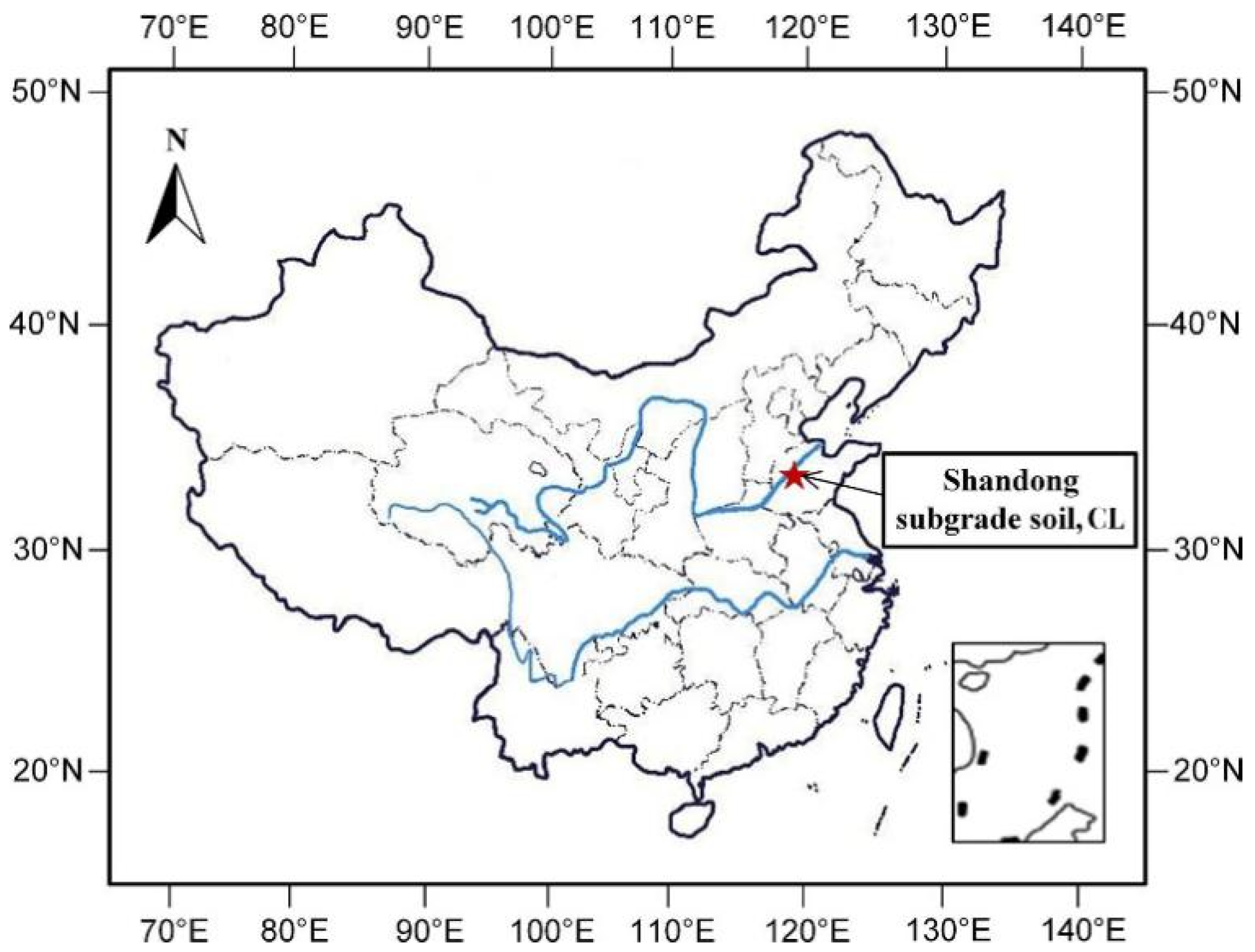
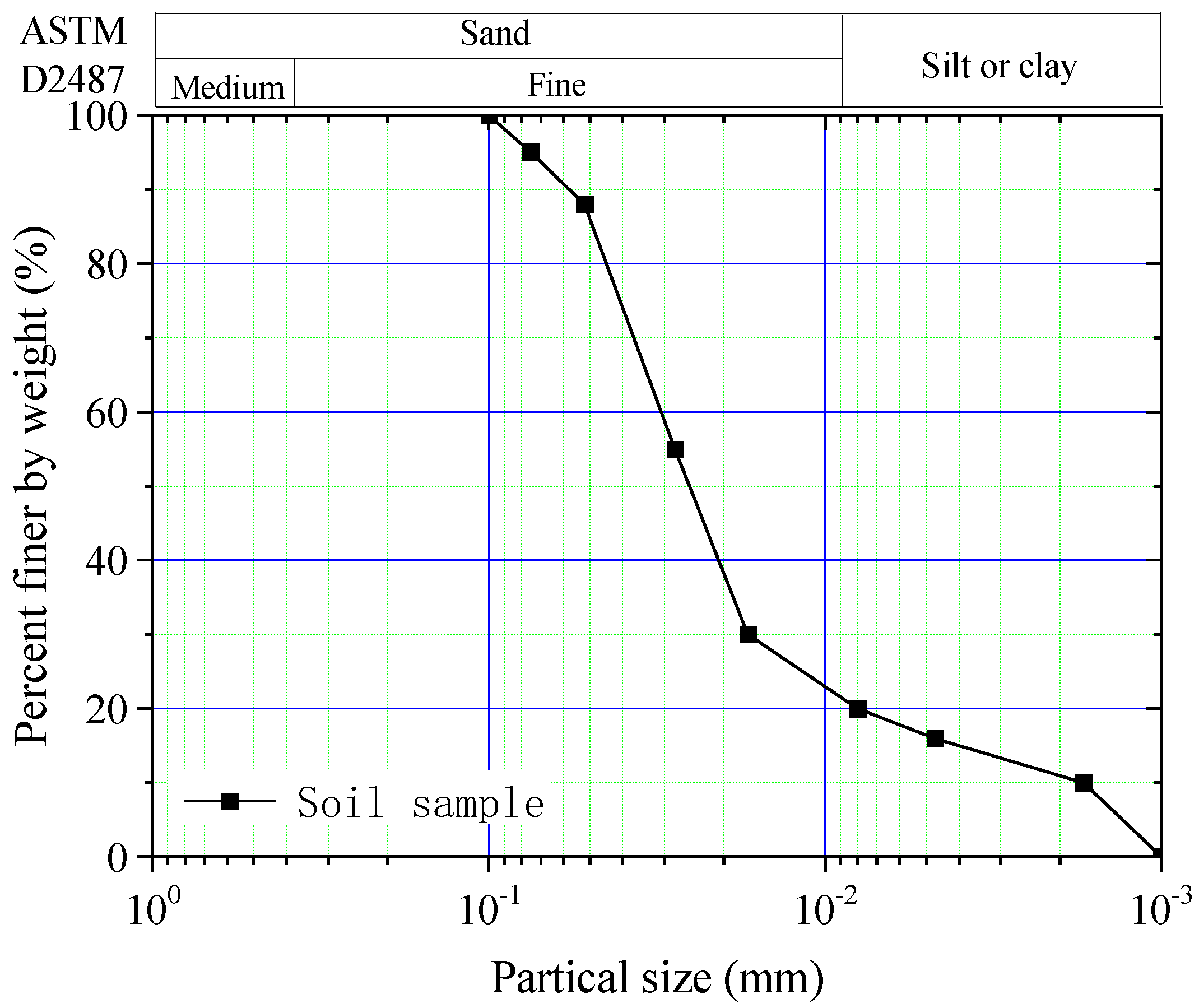
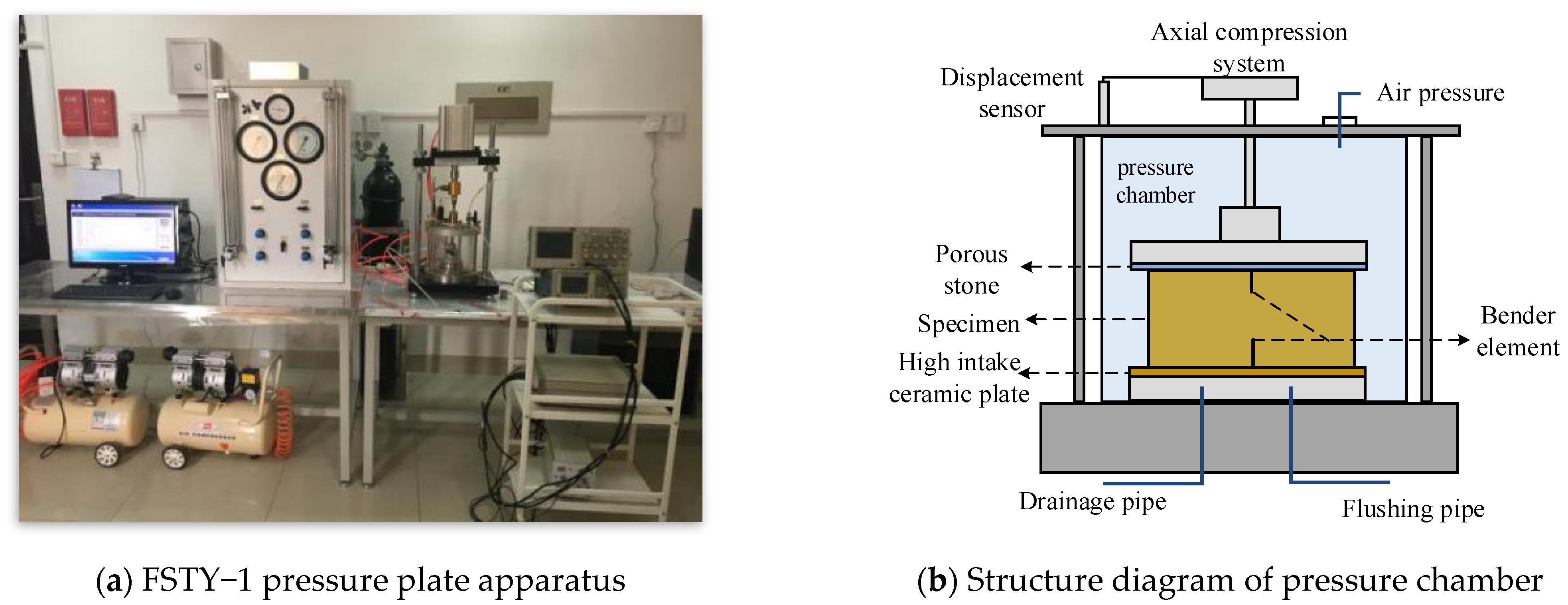
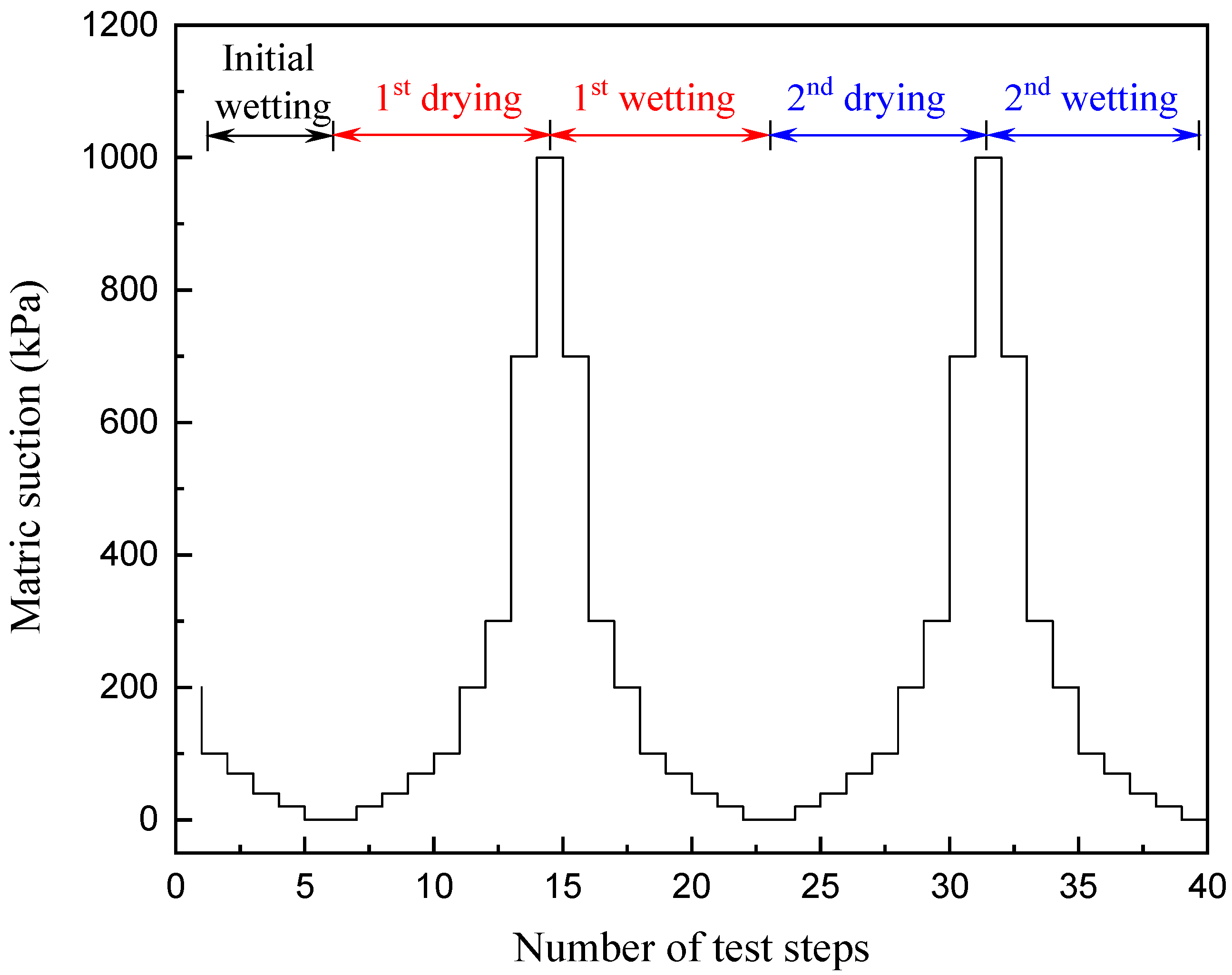
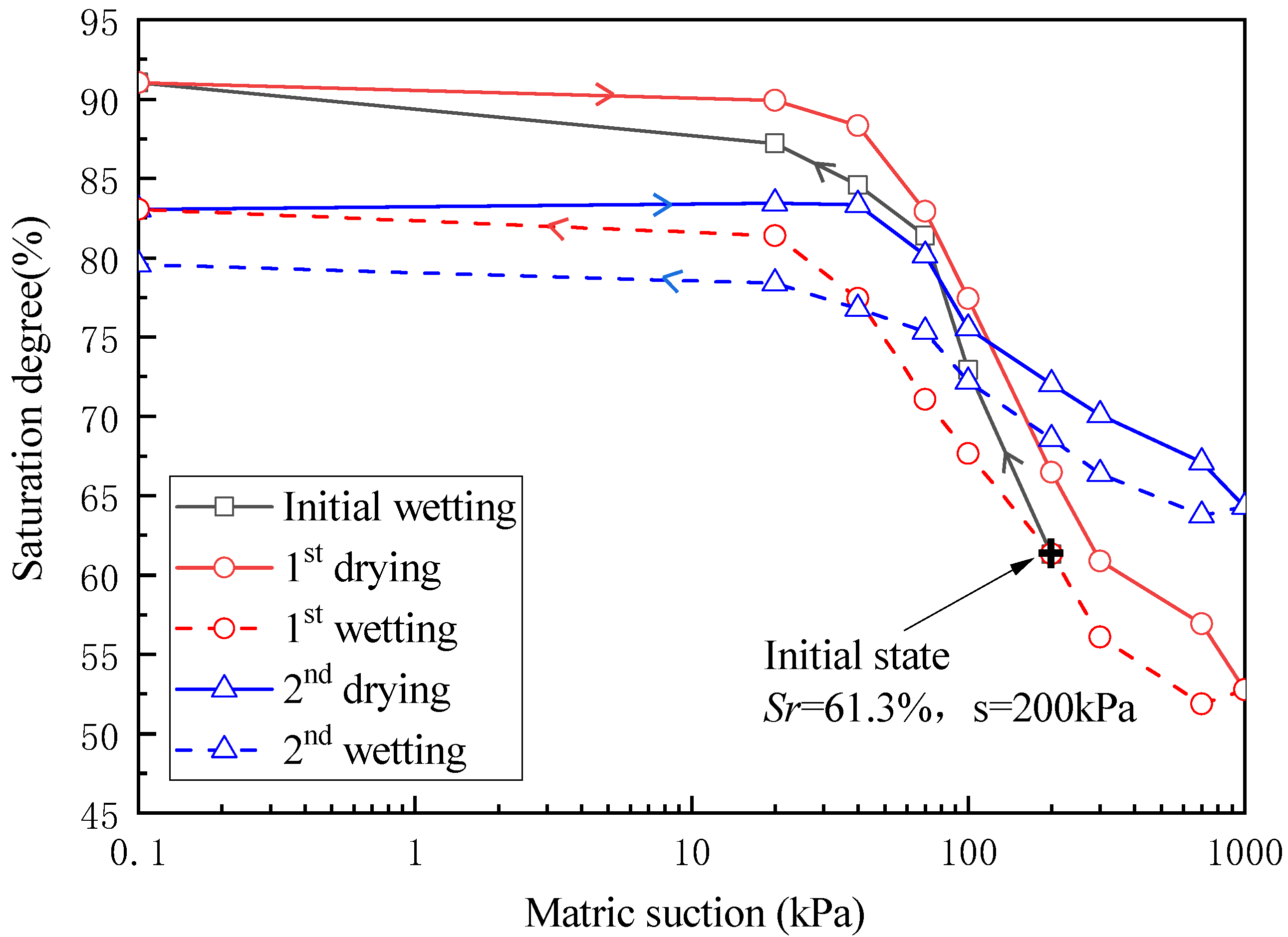
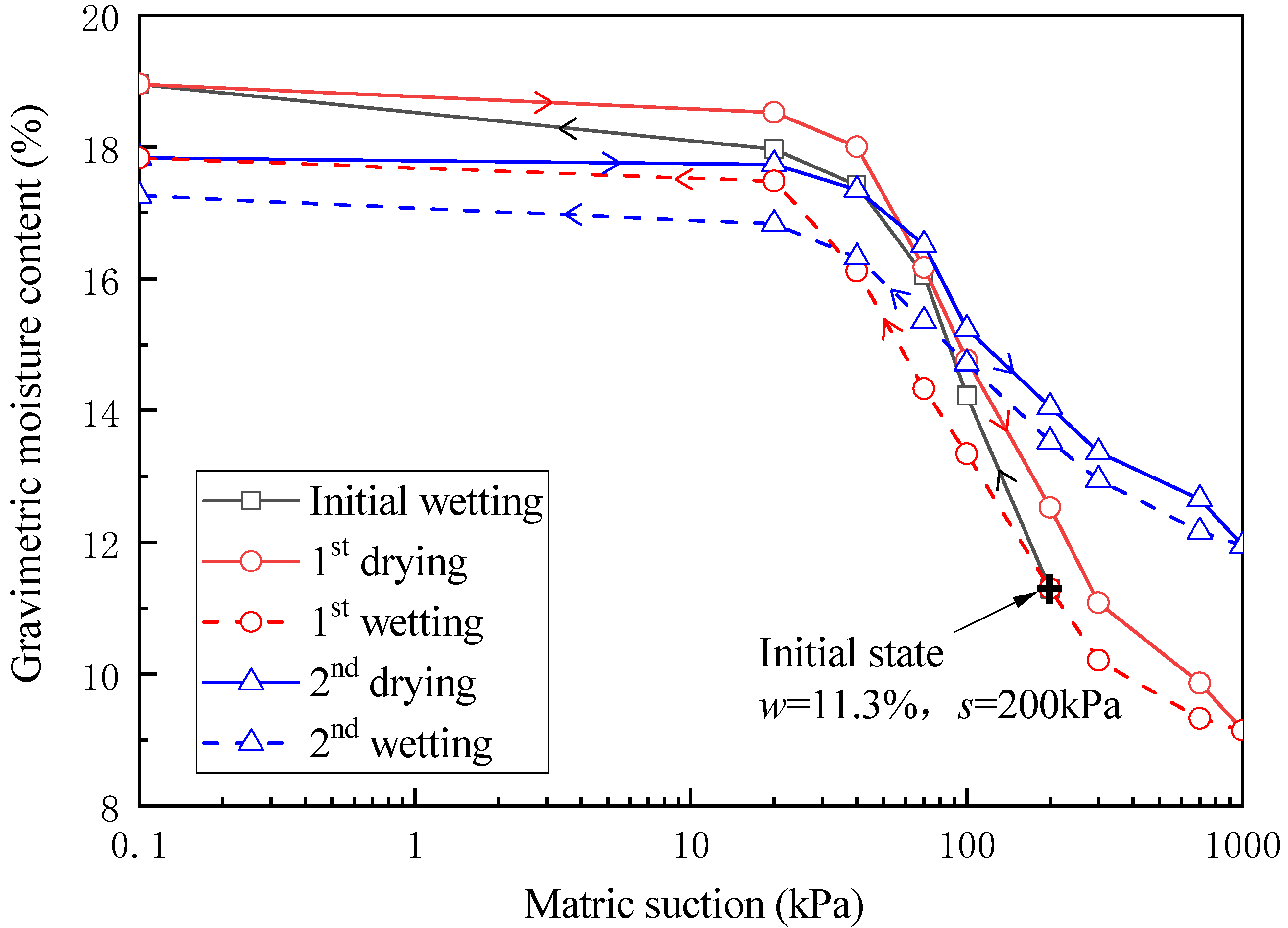
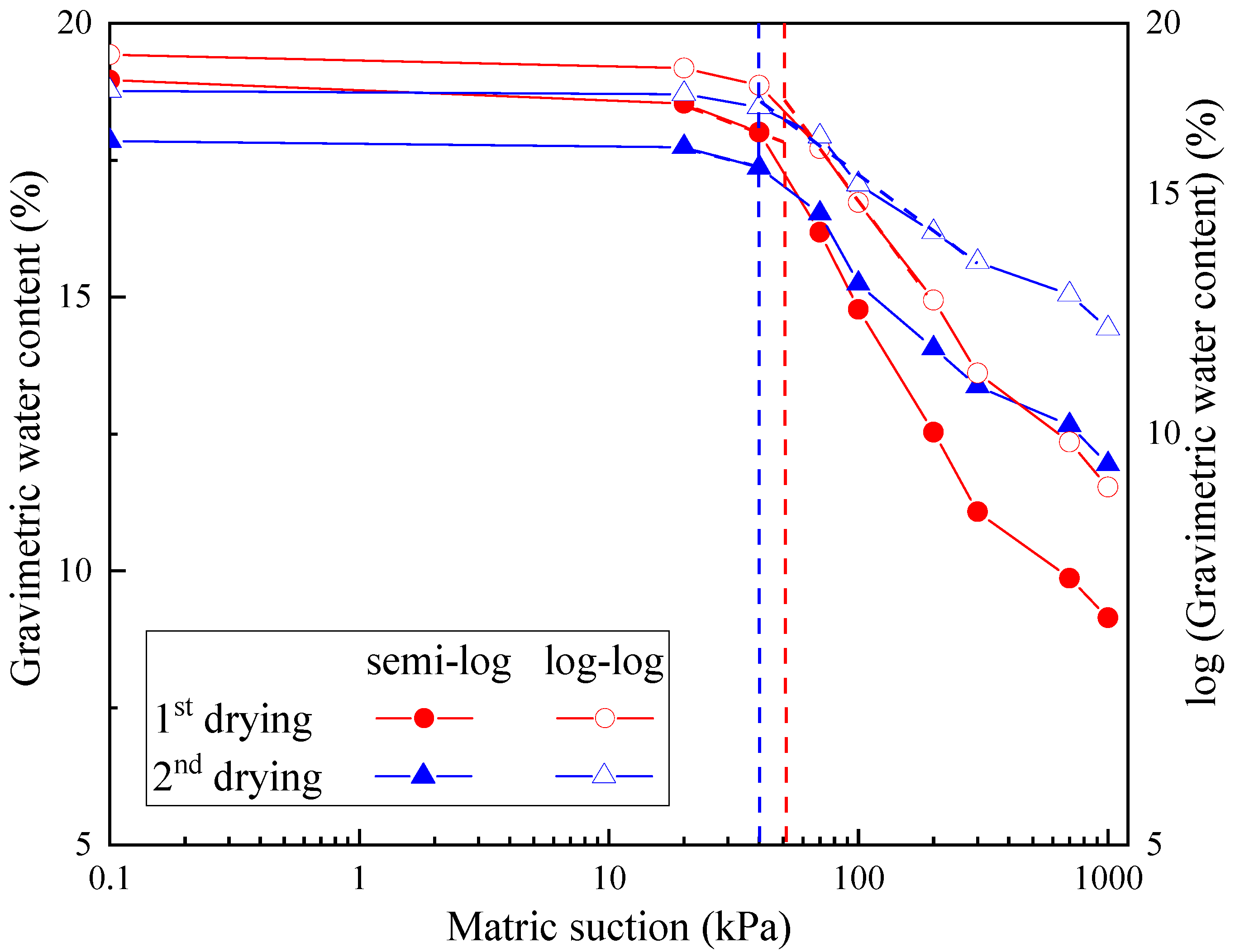
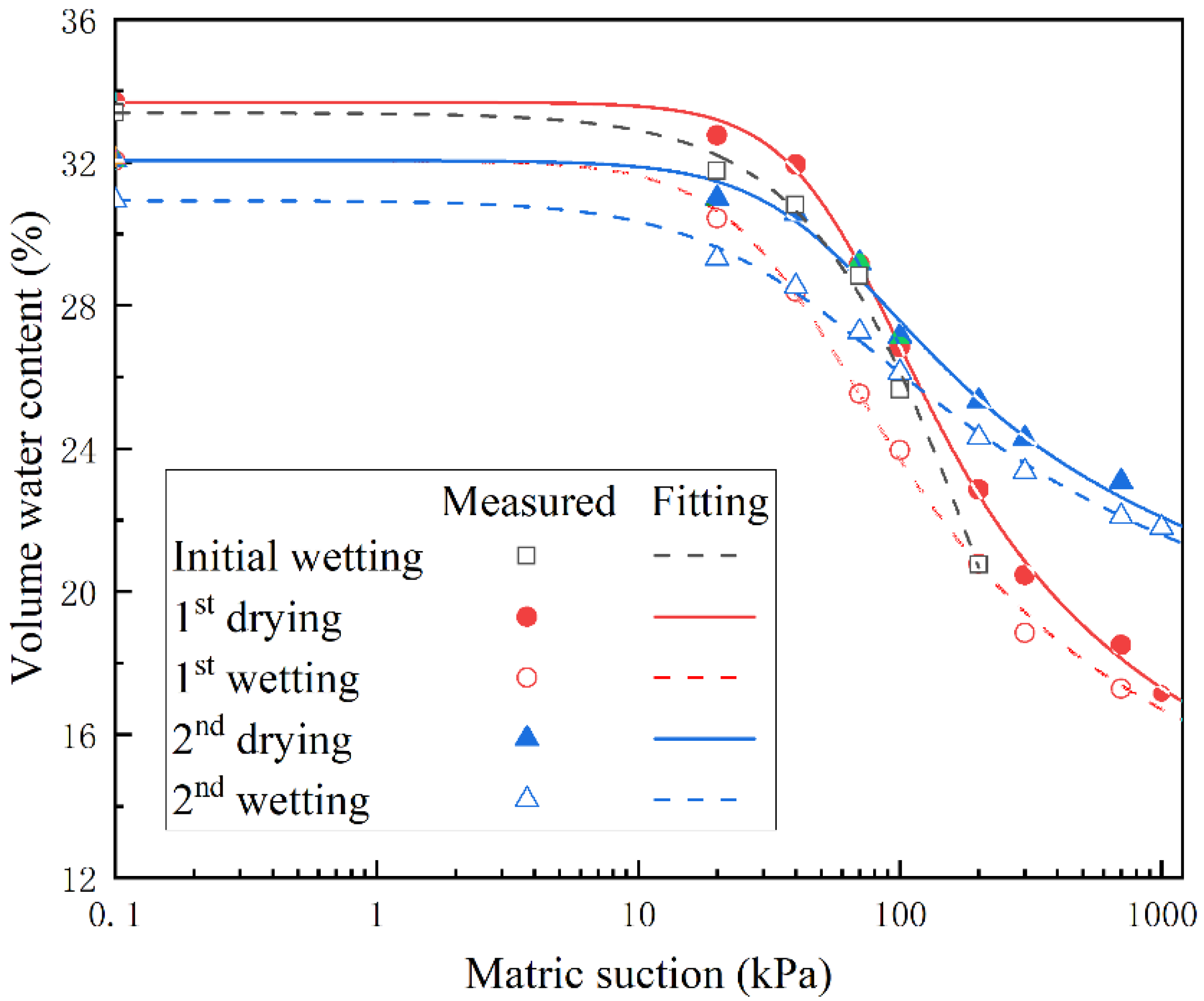




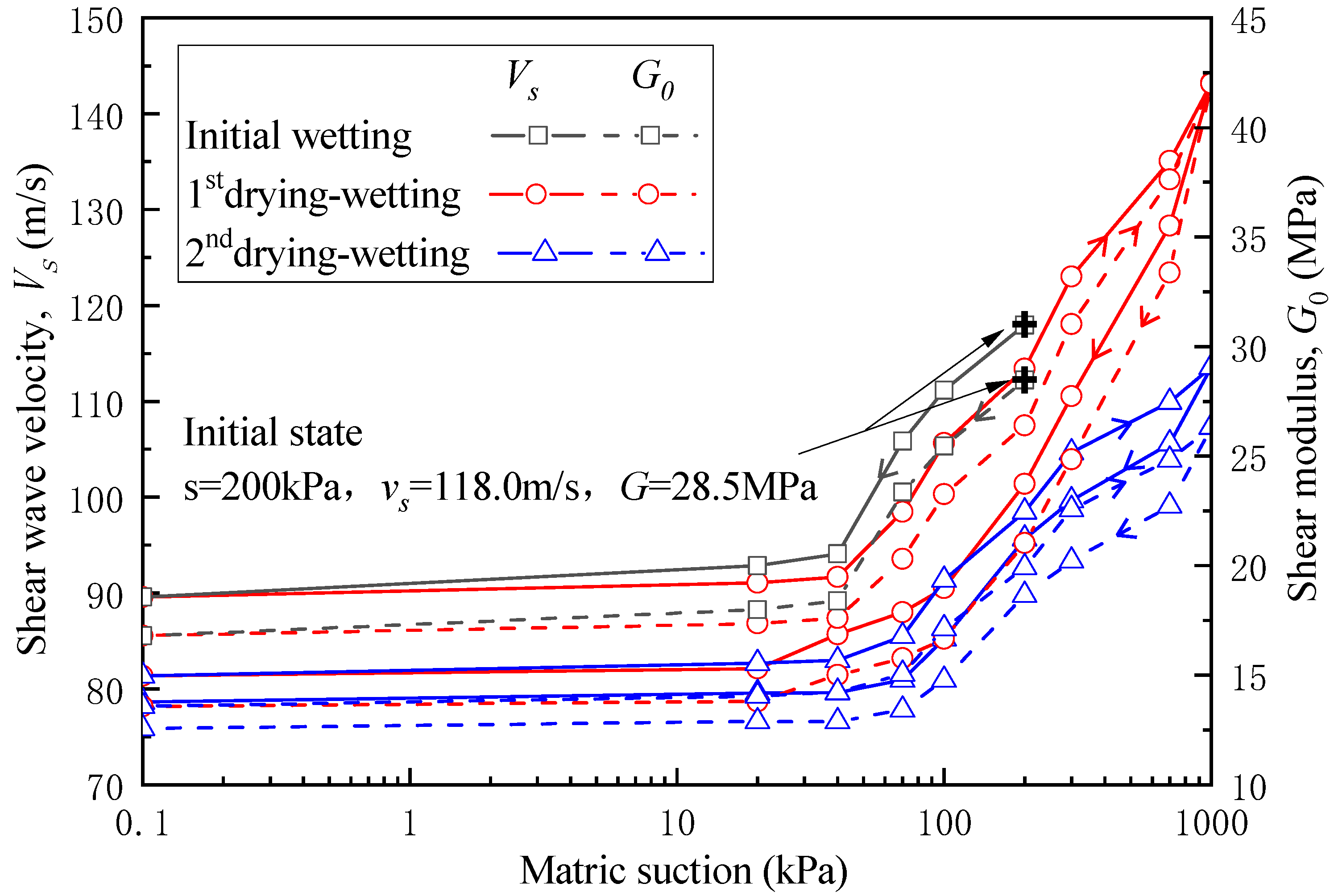

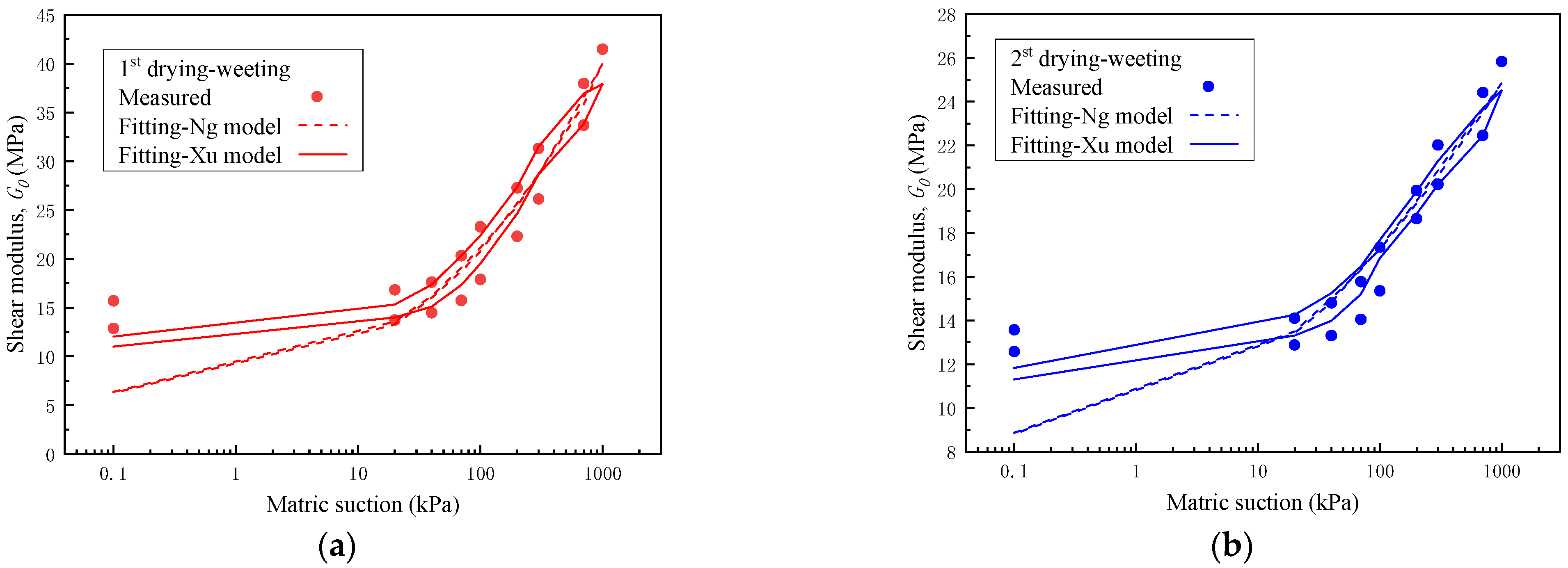
| Parameters | Initial Wetting | First Drying | First Wetting | Second Drying | Second Wetting |
|---|---|---|---|---|---|
| a | 137.75 | 54.07 | 33.02 | 41.55 | 28.26 |
| b | 1.30 | 2.17 | 1.85 | 1.83 | 1.34 |
| c | 1.25 | 0.36 | 0.35 | 0.21 | 0.23 |
| Ψr | 3.23 × 106 | 7.59 × 107 | 2.56 × 107 | 1.39 × 107 | 2.92 × 107 |
| R2 | 0.988 | 0.998 | 0.997 | 0.989 | 0.995 |
| Test Conditions | Parameters | R2 | |||
|---|---|---|---|---|---|
| e0 | a | β | γ | ||
| first drying cycle | 0.44 | 2.98 | 2.10 | −1.50 | 0.97 |
| second drying cycle | 0.48 | 0.86 | 0.23 | −2.59 | 0.98 |
| Test Conditions | Parameters | R2 | |||
|---|---|---|---|---|---|
| χ | p | q | er | ||
| first wetting cycle | 0.024 | 8.61 | 0.51 | 0.47 | 0.98 |
| second wetting cycle | 0.022 | 26.26 | 0.14 | 0.50 | 0.98 |
| Parameter | a | b | c | Ψr | R2 |
|---|---|---|---|---|---|
| Value | 40.36 | 1.67 | 0.41 | 5.25 × 106 | 0.94 |
| Test Conditions | Parameters (Xu Model) | Parameters (Ng Model) | |||||
|---|---|---|---|---|---|---|---|
| a | b | C | R2 | a | C | R2 | |
| first cycle | 0.037 | −1.15 | 37.62 | 0.82 | 0.13 | 2.09 | 0.83 |
| second cycle | 0.028 | −1.20 | 40.15 | 0.86 | 0.070 | 2.51 | 0.82 |
Disclaimer/Publisher’s Note: The statements, opinions and data contained in all publications are solely those of the individual author(s) and contributor(s) and not of MDPI and/or the editor(s). MDPI and/or the editor(s) disclaim responsibility for any injury to people or property resulting from any ideas, methods, instructions or products referred to in the content. |
© 2023 by the authors. Licensee MDPI, Basel, Switzerland. This article is an open access article distributed under the terms and conditions of the Creative Commons Attribution (CC BY) license (https://creativecommons.org/licenses/by/4.0/).
Share and Cite
Ma, C.; Li, J.; Jiao, F.; Liu, Y.; Feng, H.; Wang, K.; Jiang, H.; Jiang, C.; Li, Y.; Geng, X. Physical and Mechanical Behaviors of Compacted Soils under Hydraulic Loading of Wetting–Drying Cycles. Processes 2023, 11, 1084. https://doi.org/10.3390/pr11041084
Ma C, Li J, Jiao F, Liu Y, Feng H, Wang K, Jiang H, Jiang C, Li Y, Geng X. Physical and Mechanical Behaviors of Compacted Soils under Hydraulic Loading of Wetting–Drying Cycles. Processes. 2023; 11(4):1084. https://doi.org/10.3390/pr11041084
Chicago/Turabian StyleMa, Chuanyi, Jinglei Li, Fangfang Jiao, Yiyi Liu, Haojie Feng, Kai Wang, Hongguang Jiang, Chao Jiang, Yixin Li, and Xueyu Geng. 2023. "Physical and Mechanical Behaviors of Compacted Soils under Hydraulic Loading of Wetting–Drying Cycles" Processes 11, no. 4: 1084. https://doi.org/10.3390/pr11041084
APA StyleMa, C., Li, J., Jiao, F., Liu, Y., Feng, H., Wang, K., Jiang, H., Jiang, C., Li, Y., & Geng, X. (2023). Physical and Mechanical Behaviors of Compacted Soils under Hydraulic Loading of Wetting–Drying Cycles. Processes, 11(4), 1084. https://doi.org/10.3390/pr11041084






